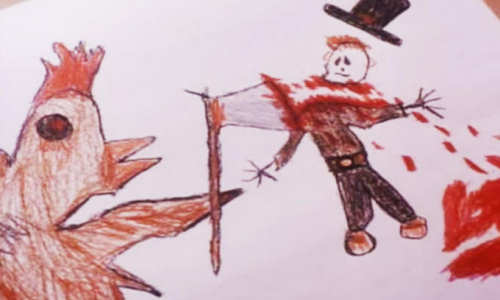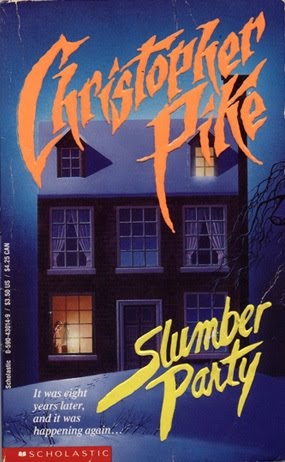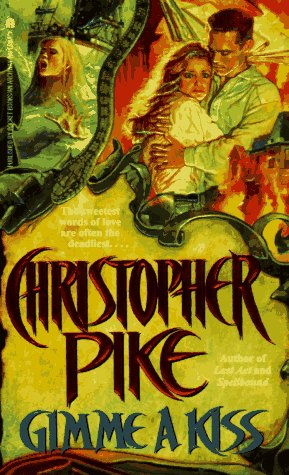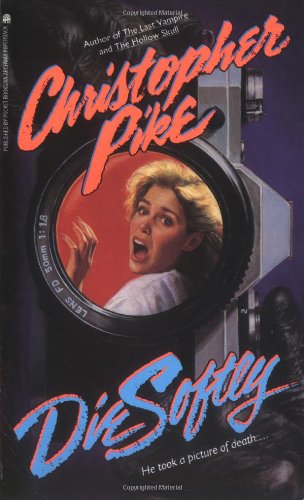If I close my eyes, I can still picture it.
In fourth grade, my teacher asked us to write a book report and to attach a bookmark featuring a scene from the book. I remember sitting at my desk, pencil poised over the narrow strip of white paper while I waited for inspiration. When it finally came, I drew an arm from the elbow down, the hand clutching a baseball bat, and below that, the head and shoulders of a blonde cheerleader, her eyes closed, a trickle of blood streaming from her head and swirling with water as it runs down a shower drain.

I no longer have the bookmark. Or if I do, it’s packed away somewhere. The above is an image from the film Mikey (1992).
There will be some twenty-year-old spoilers past this point, so hardcore purists beware!
That night, my teacher called my mom to discuss the novel I’d chosen for my book report — Die Softly by Christopher Pike. If you haven’t read it, it’s about a boy who sets up a hidden camera in the girls’ locker room in the hopes of photographing showering students. (That’s creepier to me now than it was at the time. Keep in mind, I was raised on comedy movies of the ’70s and ’80s, where the “boys will be boys” maxim often ruled.) Instead, he catches part of a murder. When he digs deeper, he discovers an underground coke (the drug, not the pop) ring in his high school before the head cheerleader, his mega-crush and one of the leaders of the ring, ties him to his bed, puts duct tape over his mouth, holds a fistful of cocaine under his nose, and forces him to overdose. And just when you think she might get away with it, you find out the boy set up his camera one last time, catching both his murder and murderess on film. The end!
Anyway, my teacher called to express her concern about my choice of reading material.
My mom’s response: “Yeah, I don’t know why she likes those books, either.”
Teacher: “Perhaps she would prefer something — ”
Mom: “No, she’s good.”
I was lucky in that my mom never stopped me from reading Pike’s books. Nor did she discourage me from the any of the other authors or series that fed into the YA horror glut of the late ’80s and early to mid-’90s. If a book had a dark cover with a frightened girl, a headstone, a shadowy house, and/or an ominous tag line on the front — “She went to camp for the arts and crafts, but she ended up tangled in a lanyard of murder!” — then I was in. I wandered down Fear Street as often as I could. I devoured the books of R. L. Stine, A. Bates, Richie Tankersley Cusick, Lois Duncan, and they collectively ruined me for night babysitting all through my adolescence. Eventually I graduated to Stephen King, but the YA books I remember best, the ones I read and reread most often, were those by Christopher Pike. It wasn’t until recently that I figured out why.
In my dorky youth, I first gravitated toward Christopher Pike because he had the same name as a character from Star Trek. I didn’t realize until I was much older that Christopher Pike was, and still is, the pen name for the rather reclusive Kevin Christopher McFadden. According to the little I was able to discover online, he first tried writing adult thrillers and turned to YA horror at the behest of some editors. His first book was Slumber Party, a book about a group of girls who’ve known each other for years. They decide to get together for a skiing weekend, only to get snowed in with a couple of rando guys. Secrets come out and horror hijinks ensue. The book hit a chord with readers, and the rest was, as they say, a steaming mug of clam chowder. (That’s a reference to The Good Place. Too obscure?)

At any rate, Pike was a machine, churning out teen terror fuel on the reg for years, and while his characters varied from book to book, there was one type that showed up again and again: the Bad Final Girl. What is a Bad Final Girl? I’m glad you asked.
If you’re at all familiar with horror, then you’ve probably heard of the Final Girl. Before it was a movie, it was a concept introduced in 1992 by Carol J. Clover, author of Men, Women, and Chain Saws: Gender in the Modern Horror Film. The classic example is Laurie Strode, Jamie Lee Curtis’ character in Halloween, Halloween II, and Halloween H20: 20 Years Later. Even though Laurie wasn’t the first, and she’s an imperfect example since she’s rescued by Dr. Loomis at the end of the first movie — a better one would be Wendy Torrance in the 1980 version of The Shining — but Laurie works for our purposes because the most common characteristic of a Final Girl is that they’re a “good girl.” Good in the sense that they don’t drink, smoke, swear, have sex, etc. — their general purity being the prerequisite for surviving the murder spree and triumphing over the bad guy (until, of course, he returns in the sequel).
This concept has been thoroughly discussed and often subverted or skewered in modern pop culture, but again, in the ’80s and ’90s, it was only just being talking about. Despite that, Pike’s female characters rarely conformed to the Final Girl mold. His teenage protagonists drank, swore, smoked, and had sex. And while no, not all of them survived, some did, and even the ones who didn’t weren’t judged for their “bad” behavior.
In Gimme a Kiss, a young woman is humiliated when the contents of her journal and news of her boyfriend’s cheating ways are revealed, so she goes about framing people for her murder. (As one does.) Even though the plot hinges at least partially on sex, Pike goes out of his way to provide a sex-positive message. Several female characters are lectured about the dangers of sex, but they’re also offered condoms, and the girls only take them once they’ve determined the prophylactics haven’t been tampered with.

In Slumber Party, Pike’s first foray into the genre, there’s a moment in the first thirty pages of the book where the main character chastises another female character for holding their mutual friend responsible for the actions of some rando guy. Lara even goes so far as to refer to Mindy as “anti-feminist,” a sadly progressive viewpoint for 1985 — the year the book was first published.
To be fair, there is a large amount of girl-on-girl crime in Pike’s books. But that’s because large casts of young women were often his central characters. And the girls never judge or punish one another for drinking or swearing or having sex. They judge one another for lying, cheating, and/or bullying. They’re punished for being bad friends, for hurting others.
Keep in mind that, in Gimme a Kiss, the philandering boyfriend is held just as accountable as the friend. In fact, liars, cheaters, and bullies of both genders are punished throughout Pike’s books. If we go back to Die Softly, even Herb — that was the photo-creeper’s name — ends up paying for his perverted desire to spy on girls in the locker room with his death.
Not only did Pike not punish his female characters for being sexual creatures, he often put his girls in the position of aggressor when it came to sex and romance. His girls would go out actively looking for boys, and then it was often the girls who suggest meeting up later. They aren’t punished for this, either. In Slumber Party, you might imagine it’s the rando guys who end up being the killers. That is, after all, the typical outcome. But they aren’t. The killers’ grudges go back to a slumber party years earlier, when an ill-advised round of demon summoning went awry, resulting in disfiguring burns and a supposed death. The killers’ revenge has nothing to do with the boys, which grows apparent when they join the list of victims, and everything to do with being a dish best served cold.

Point is, I was inculcated with the notion that I could do many of the stupid and/or normal stuff that teens of all genders do and still be worthy of making it to the credits, of surviving the murder spree, of taking down the bad guy (or girl). My virginity wasn’t a “Get Out of Massacre Free” card, and I wouldn’t be any less feminine or cunning if I dropped an F-bomb or hit on a guy or drank a beer at a party. By reading and rereading Pike’s books, his smart, assertive female characters became my norm, both in fiction and in life. To this day, I conduct myself as I see fit, and I continue to seek out entertainment populated by complex female characters. So even though I don’t know why in the name of George Romero my mother let me read Pike’s twisted books, I’m sure glad she did.
In case you’re wondering, Pike is still writing and a handful of books from his heyday are still in print. (You can find the Remember Me series and The Thirst series published as door-stopper omnibuses.) But a lot of his books are out of print, so I encourage you to dig them out of the boxes in your parents’ basements, to find them in libraries or online, and experience them once again. Or track them down and read them for the first time. I promise you, they’re worth the effort.

I was more of an R.L. Stine girl growing up, because Christopher Pike’s stuff scared me (I was a wuss). I did read a few titles, notably Witch and The Immortal. I may have read more, in fact I’m sure I did, but I can’t remember. I recognize a lot of covers and a lot of titles, but I also spent a lot of time staring at stuff in bookstores.
Great post, btw! I’d love to read some of these now with adult eyes and see how they hold up!
I’ve been rereading a lot lately, and they hold up pretty well! It’s funny all the little details I remembered. Like, Pike was a big fan of using emeralds as clues. I wonder if they’re his birthstone too…
Like, Pike was a big fan of using emeralds as clues. I wonder if they’re his birthstone too…
I LOVED Christopher Pike! I hit an age where RL Stine was too babyish but Stephen King was too nightmare fuely. I remember reading Whisper of Death at bedtime and then staying up all night — out of all Pike’s books, that one freaked me out the most. I still love Season of Passage.
Ha! Nice! Yeah, the book that lodged in my head most firmly is Monster–the book I probably remember the least about. I’m looking forward to rereading it and re-traumatizing myself all over again.
Those Christopher Pike books could not come out fast enough for me back in the day. And they served as my Stephen King gateway drug.
Me too! I’m glad so many other people remember his books as fondly as I do.
I just started buying them wherever I find them (my massive collection sadly did not survive the years) for my daughter – they’re totally not shut away in my own library closet…
Now that’s some smart thinking! I wish my mom had been into Pike too, but she always hated horror.
I wish my mom had been into Pike too, but she always hated horror.
I have to laugh because I know that there are bound to be some Christopher Pike books in my parents’ basement. I was addicted to them in middle school but I don’t remember them as well as you do. I remember I really liked The Cold One, but I think that was actually one of his books for adults.
I looove Christopher Pike! Recently, I’ve been trying to track down his books I don’t own, at thrift book stores. He was a huge part of my teenage and young adult years, you can easily get lost in his books. Such as excellent writer